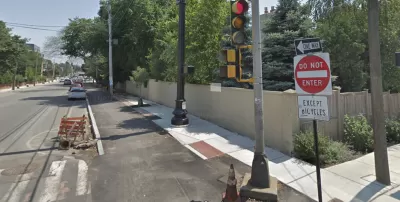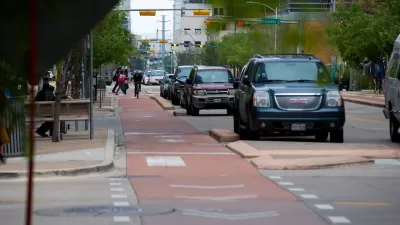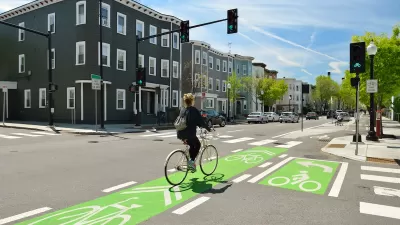You've probably never seen anything like this before, but if you're a bike advocate, it probably still feels familiar.

Steve Annear reports on a new entry in the annals of crime against bike lanes.
In the city of Somerville, a brand new cycle track on Beacon Street includes a utility pole "smack-dab" in the middle of the raised, painted lane.
The poorly placed pole was first documented by Ian Woloschin shared a picture on a Facebook group for local cyclists that you'll have to click through to the source article to see for yourself.
So far, it looks like the state is responsible for the snafu.
"According to the city’s website, in 2016 the Massachusetts Department of Transportation began a multi-modal, 'full-depth reconstruction' of Beacon Street, a project that includes the installation of an “exclusive bike lane that is separated from the roadway and traffic," according to Annear.
"Denise Taylor, a spokeswoman for Mayor Joseph Curtatone’s office, stressed in a statement Monday that the bike lane, sidewalk, and road repairs are being handled by Newport Construction, under a contract with MassDOT." Designs for the project, created in 2015, show the pole being relocated.
In addition to the jaw-dropping photo documentation, the article includes a lot more details about how this fugazi came to be, and what city officials are promising can be down to fix it.
FULL STORY: ‘It’s not supposed to be there’: A utility pole is blocking a new Somerville bike lane

Alabama: Trump Terminates Settlements for Black Communities Harmed By Raw Sewage
Trump deemed the landmark civil rights agreement “illegal DEI and environmental justice policy.”

Planetizen Federal Action Tracker
A weekly monitor of how Trump’s orders and actions are impacting planners and planning in America.

The 120 Year Old Tiny Home Villages That Sheltered San Francisco’s Earthquake Refugees
More than a century ago, San Francisco mobilized to house thousands of residents displaced by the 1906 earthquake. Could their strategy offer a model for the present?

In Both Crashes and Crime, Public Transportation is Far Safer than Driving
Contrary to popular assumptions, public transportation has far lower crash and crime rates than automobile travel. For safer communities, improve and encourage transit travel.

Report: Zoning Reforms Should Complement Nashville’s Ambitious Transit Plan
Without reform, restrictive zoning codes will limit the impact of the city’s planned transit expansion and could exclude some of the residents who depend on transit the most.

Judge Orders Release of Frozen IRA, IIJA Funding
The decision is a victory for environmental groups who charged that freezing funds for critical infrastructure and disaster response programs caused “real and irreparable harm” to communities.
Urban Design for Planners 1: Software Tools
This six-course series explores essential urban design concepts using open source software and equips planners with the tools they need to participate fully in the urban design process.
Planning for Universal Design
Learn the tools for implementing Universal Design in planning regulations.
Clanton & Associates, Inc.
Jessamine County Fiscal Court
Institute for Housing and Urban Development Studies (IHS)
City of Grandview
Harvard GSD Executive Education
Toledo-Lucas County Plan Commissions
Salt Lake City
NYU Wagner Graduate School of Public Service





























